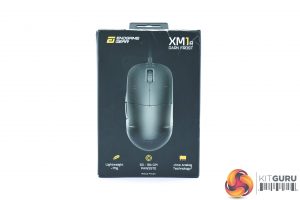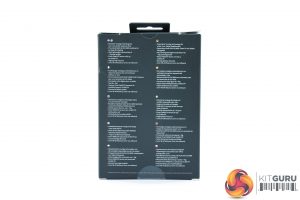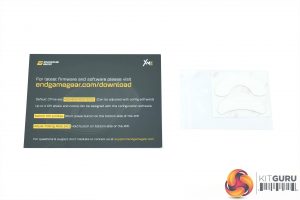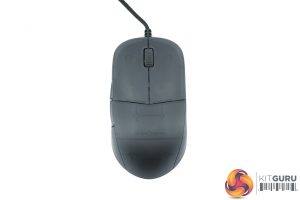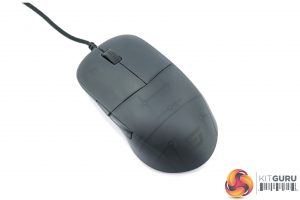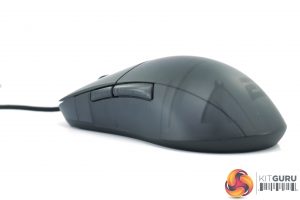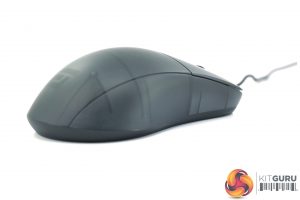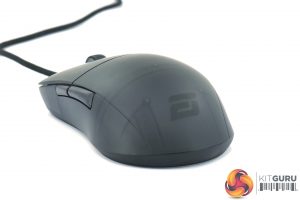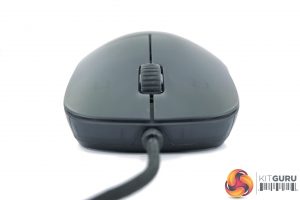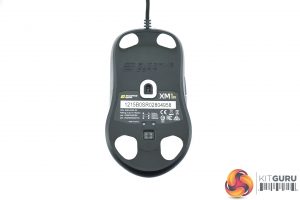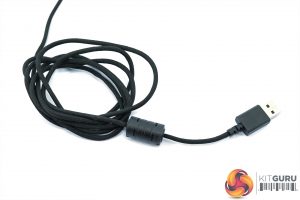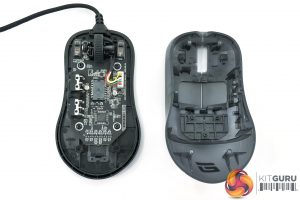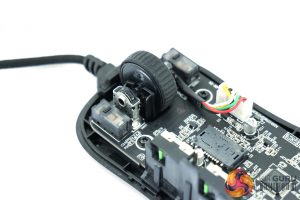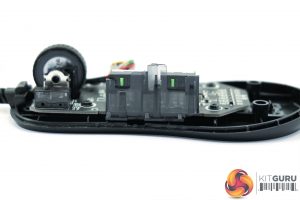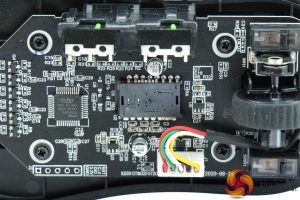The Endgame Gear XM1r ships in a fairly plain black box, with an image of the mouse visible on the front, alongside some product branding and three key features. On the back we find some multi-lingual product information.
Inside, a small note about where to download the accompanying software suite is included, alongside two replacement mouse feet – more on the feet below.
Looking at the XM1r itself, the shape of the mouse has not changed since the original model launched two years ago. That means it's a symmetrical design, though it's not what I'd class as ambidextrous as there are only side buttons on the left-hand side. It measures 122.14 x 65.81 x 38.26 mm (L x W x H), with a fairly wide rear end, while the height tapers off at the front of the mouse. It also weighs in at 70g, which is again the same as the original XM1.
The XM1r does sport a new shell design though, with some translucent plastic used, and you can just about see through to some of the internals. My sample is the Dark Frost model, though there is a glossy Dark Reflex translucent model as well, or your standard black and white colour options which are not translucent. Personally I really like the Dark Frost look, and it's certainly something a bit different to what we are used to seeing.
The left side of the mouse is home to two side buttons, with the rear button proving to be slightly longer than the forward-most button. The right-hand side is left bare, and as you can see the entirety of the mouse is made of the same plastic material – there's no textured side grips or anything like that. We discuss grip and comfort on the next page.
The rear of the mouse is home to the Endgame Gear logo which almost blends in with the plastic surrounding it, so it is easy to miss. Do note that this logo does not light up with RGB LEDs, and there is actually no RGB lighting on the mouse at all, aside from the DPI indicators on the underside of the mouse.
At the front, we can note the separate primary buttons as well as the textured rubber scroll wheel, the design of which remains unchanged from the original XM1.
Turning the mouse over, we can take a look at the four PTFE feet, again using the same shape as the original XM1. You can see, however, there is an outline for where the other included mouse feet can go – so if you want to, you could replace the pre-installed smaller mouse feet with the two larger ones, and that is a nice touch from Endgame Gear.
We can also see a small button towards the bottom of the mouse which enables users to adjust DPI settings on the fly. Above it, the two small dots are tiny RGB LEDs which change colour based on what DPI setting is currently in use. Whether both, or just one, of these LEDs light up depends on what polling rate is enabled, though this is set at 1000Hz by default.
Then for the cable, Endgame Gear calls this the Flex Cord 2.0, and it measures approximately 1.9m and is a paracord-style design. It uses a standard USB 2.0 Type-A connector.
We can see most of the primary differences versus the original XM1 when opening up the shell. First of all, Endgame Gear is now using Kailh GM 8.0 switches for the XM1r's primary buttons, when the XM1 uses Omron D2FC-F-K(50M). The scroll wheel uses a Japanese ALPS encoder, with a Kailh switch used for the scroll click.
The side buttons, while still from TTC as per the original XM1, have also been updated, with Endgame Gear claiming a ‘crisper and more consistent click'. Lastly, the sensor is now a PixArt PAW 3370, compared to the PMW 3389 used with the XM1. This has a higher native DPI of 19000, compared to 16000 of the 3389, and a lower error rate.
 KitGuru KitGuru.net – Tech News | Hardware News | Hardware Reviews | IOS | Mobile | Gaming | Graphics Cards
KitGuru KitGuru.net – Tech News | Hardware News | Hardware Reviews | IOS | Mobile | Gaming | Graphics Cards


